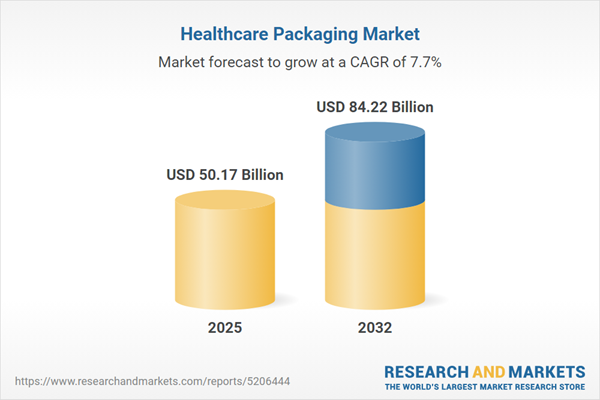Speak directly to the analyst to clarify any post sales queries you may have.
The healthcare packaging market is undergoing significant transformation as both regulatory demands and sustainability objectives drive innovation across the entire value chain. Senior leaders face increasing pressure to enhance product safety, streamline supply networks, and accelerate digital adoption while ensuring environmental compliance.
Market Snapshot: Healthcare Packaging Market Overview
The Healthcare Packaging Market grew from USD 46.54 billion in 2024 to USD 50.17 billion in 2025, and is projected to sustain a compound annual growth rate (CAGR) of 7.69%, reaching USD 84.22 billion by 2032.
Market expansion is fueled by rising demand for secure, traceable, and environmentally sound packaging solutions across pharmaceuticals, medical devices, and biopharmaceuticals, shaping competitive priorities worldwide.Scope & Segmentation of the Healthcare Packaging Market
- Sterility – Non-sterile (bulk packaging, non-aseptic) and sterile formats (aseptic fill-finish, terminally sterilized) are integral in addressing shifting infection control and operational efficiency.
- Product Types – The landscape covers biopharmaceuticals (monoclonal antibodies, recombinant proteins, vaccines), medical devices (diagnostics, implants, surgical instruments), and pharmaceuticals (liquid, semi-solid, solid dosage forms).
- Packaging Types – Primary (ampoules, blisters, bottles, prefilled syringes, vials), secondary (cartons, sleeves, trays), and tertiary packaging (cases, containers, pallets) all enable protection, logistics, and regulatory fulfillment.
- Dose Formats – Multi-dose units (bottles, cartridges, vials) and single-dose formats (ampoules, blisters, prefilled syringes) align with cost optimization and patient safety needs.
- Packaging Materials – Segments include glass (Type I, II, III), metals (aluminum, steel), paperboard (corrugated, folding), plastics (HDPE, PET, PP, PVC) for their varied performance, sustainability attributes, and processing strengths.
- Regional Coverage – Americas (United States, Canada, Mexico, Brazil, Argentina, Chile, Colombia, Peru); Europe, Middle East & Africa (United Kingdom, Germany, France, Russia, Italy, Spain, Netherlands, Sweden, Poland, Switzerland, United Arab Emirates, Saudi Arabia, Qatar, Turkey, Israel, South Africa, Nigeria, Egypt, Kenya); and Asia-Pacific (China, India, Japan, Australia, South Korea, Indonesia, Thailand, Malaysia, Singapore, Taiwan).
- Leading Companies – Report features Amcor plc, Berry Global Group, WestRock, Sealed Air, Mondi, Sonoco, AptarGroup, Gerresheimer, Schott AG, and Constantia Flexibles among others.
Key Takeaways for Senior Decision-Makers
- Sustainability has emerged as a top buyer requirement, driving investment in biopolymer blends, recycled content, and new material science innovations throughout the packaging sector.
- Digitally enabled packaging, such as RFID and QR code integration, is strengthening traceability, reducing the risk of counterfeiting, and optimizing logistics processes for sensitive therapies like biologics and vaccines.
- Regulatory frameworks continue to evolve, compelling tighter compliance around sterilization, serialization, and chain of custody, influencing production investments and supplier selection.
- Advanced cold chain solutions, including automated temperature monitoring and predictive logistics technologies, are essential to maintaining pharmaceutical integrity and supporting global vaccine distribution.
- Regional variations in packaging adoption highlight the need for scalable, modular automation strategies and cross-country alliance models, as infrastructure and regulatory maturity differ across global markets.
- Strategic collaborations—spanning logistics providers, technology start-ups, and pharmaceutical partners—accelerate time to market for next-generation packaging, while fostering R&D and operational efficiency.
Tariff Impact on United States Healthcare Packaging Market
Newly introduced U.S. tariff measures have shifted cost dynamics for polymer resins and specialized films, prompting reassessment of supply sources, increased interest in nearshoring, and market consolidation among domestic suppliers. These regulatory adjustments have required procurement and logistics teams to overhaul distribution strategies and renegotiate relevant contracts to secure steady access to critical packaging components.
Methodology & Data Sources
This report leverages a multi-tiered research methodology: primary interviews with packaging engineers, regulatory experts, and supply chain analysts are complemented by a secondary review of peer-reviewed journals, industry filings, and global trade data. Validation includes cross-referencing insights with subject-matter experts and triangulation against material consumption and shipment volumes to underpin comprehensive, trustworthy analysis.
Why This Report Matters
- Strategic leaders gain actionable insight into key technologies, standards, and partnership opportunities shaping competitive advantage in healthcare packaging.
- Segmented data and regional analysis inform sourcing, investment, and expansion decisions across diverse regulatory and operational environments.
- A detailed view of tariff, regulatory, and technology shifts supports scenario planning and risk mitigation initiatives for critical supply chain continuity.
Conclusion
The healthcare packaging sector is defined by a convergence of innovation, regulatory adaptation, and sustainability imperatives. Senior decision-makers equipped with this analysis can build resilient, future-ready packaging strategies aligned with evolving industry benchmarks and growth opportunities.
Additional Product Information:
- Purchase of this report includes 1 year online access with quarterly updates.
- This report can be updated on request. Please contact our Customer Experience team using the Ask a Question widget on our website.
Table of Contents
3. Executive Summary
4. Market Overview
7. Cumulative Impact of Artificial Intelligence 2025
Companies Mentioned
The companies profiled in this Healthcare Packaging market report include:- Amcor plc
- Berry Global Group, Inc.
- WestRock Company
- Sealed Air Corporation
- Mondi plc
- Sonoco Products Company
- AptarGroup, Inc.
- Gerresheimer AG
- Schott AG
- Constantia Flexibles GmbH
Table Information
| Report Attribute | Details |
|---|---|
| No. of Pages | 199 |
| Published | November 2025 |
| Forecast Period | 2025 - 2032 |
| Estimated Market Value ( USD | $ 50.17 Billion |
| Forecasted Market Value ( USD | $ 84.22 Billion |
| Compound Annual Growth Rate | 7.6% |
| Regions Covered | Global |
| No. of Companies Mentioned | 11 |









